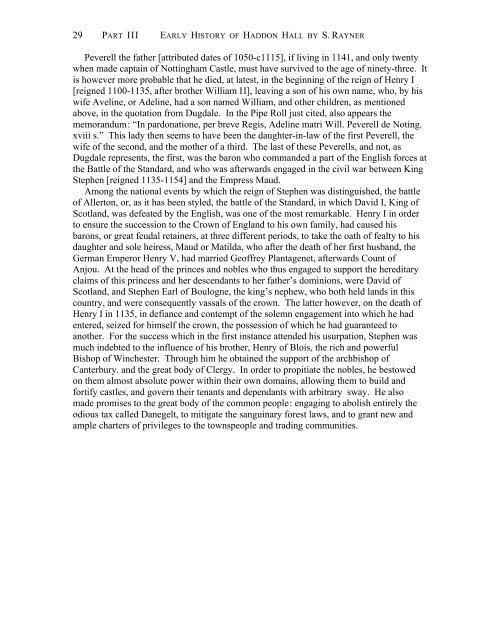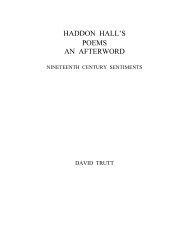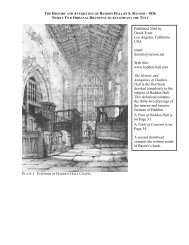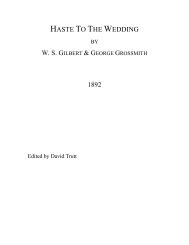Download - Haddon Hall
Download - Haddon Hall
Download - Haddon Hall
You also want an ePaper? Increase the reach of your titles
YUMPU automatically turns print PDFs into web optimized ePapers that Google loves.
29 PART III EARLY HISTORY OF HADDON HALL BY S. RAYNER<br />
Peverell the father [attributed dates of 1050-c1115], if living in 1141, and only twenty<br />
when made captain of Nottingham Castle, must have survived to the age of ninety-three. It<br />
is however more probable that he died, at latest, in the beginning of the reign of Henry I<br />
[reigned 1100-1135, after brother William II], leaving a son of his own name, who, by his<br />
wife Aveline, or Adeline, had a son named William, and other children, as mentioned<br />
above, in the quotation from Dugdale. In the Pipe Roll just cited, also appears the<br />
memorandum: “In pardonatione, per breve Regis, Adeline matri Will. Peverell de Noting.<br />
xviii s.” This lady then seems to have been the daughter-in-law of the first Peverell, the<br />
wife of the second, and the mother of a third. The last of these Peverells, and not, as<br />
Dugdale represents, the first, was the baron who commanded a part of the English forces at<br />
the Battle of the Standard, and who was afterwards engaged in the civil war between King<br />
Stephen [reigned 1135-1154] and the Empress Maud.<br />
Among the national events by which the reign of Stephen was distinguished, the battle<br />
of Allerton, or, as it has been styled, the battle of the Standard, in which David I, King of<br />
Scotland, was defeated by the English, was one of the most remarkable. Henry I in order<br />
to ensure the succession to the Crown of England to his own family, had caused his<br />
barons, or great feudal retainers, at three different periods, to take the oath of fealty to his<br />
daughter and sole heiress, Maud or Matilda, who after the death of her first husband, the<br />
German Emperor Henry V, had married Geoffrey Plantagenet, afterwards Count of<br />
Anjou. At the head of the princes and nobles who thus engaged to support the hereditary<br />
claims of this princess and her descendants to her father’s dominions, were David of<br />
Scotland, and Stephen Earl of Boulogne, the king’s nephew, who both held lands in this<br />
country, and were consequently vassals of the crown. The latter however, on the death of<br />
Henry I in 1135, in defiance and contempt of the solemn engagement into which he had<br />
entered, seized for himself the crown, the possession of which he had guaranteed to<br />
another. For the success which in the first instance attended his usurpation, Stephen was<br />
much indebted to the influence of his brother, Henry of Blois, the rich and powerful<br />
Bishop of Winchester. Through him he obtained the support of the archbishop of<br />
Canterbury. and the great body of Clergy. In order to propitiate the nobles, he bestowed<br />
on them almost absolute power within their own domains, allowing them to build and<br />
fortify castles, and govern their tenants and dependants with arbitrary sway. He also<br />
made promises to the great body of the common people: engaging to abolish entirely the<br />
odious tax called Danegelt, to mitigate the sanguinary forest laws, and to grant new and<br />
ample charters of privileges to the townspeople and trading communities.







